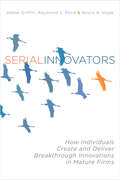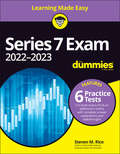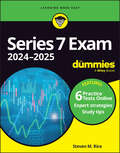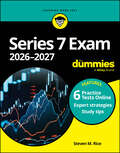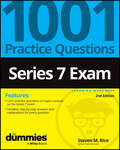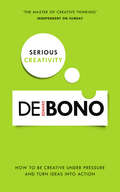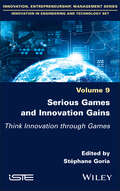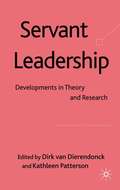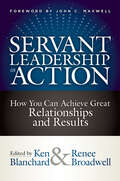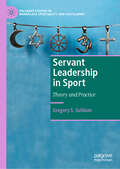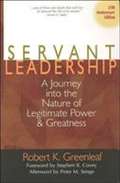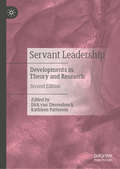- Table View
- List View
Serendipity Software
by Louis B. Barnes Martha C. PulleynTwo partners, Anne Salpryn and Tom Hilliard, successfully develop a creative software company. While Anne becomes more managerially oriented, Tom wants to remain a software project creator. The partnership becomes jeopardized as Tom's personal life begins to fall apart and he is faced with sexual harassment charges at work. Anne seeks to buy him out. Examines the perils of partnership, man/woman business relationships, and the tensions posed by creativity and organization.
Serengeti Eyewear: Entrepreneurship Within Corning, Inc.
by David A. Garvin Jonathan WestAn entrepreneurial division within Corning, Serengeti Eyewear, has grown rapidly in its brief 10-year history. Now it must decide whether to launch a new line of sunglasses and take on the industry leader. The company has prospered by developing and cultivating relationships with suppliers, customers, employees, and retailers. Its leader, Zaki Mystafa, has created a remarkable, flexible, and responsive organization. The case describes Mystafas's highly informal managerial style, and his skill at managing "up" to his superiors at Corning.
Sergio Marchionne at Chrysler
by Rob Kaplan Bernardo BertoldiChrysler recently exited from the bankruptcy process, with U.S. government support and with Sergio Marchionne as CEO. Now was the time to work out how to create synergies with FIAT, how to improve the current manufacturing, product, and distribution-network configuration, and how to define the future product portfolio to compete over the long term. In 2004, Marchionne was appointed CEO of FIAT Group, headquartered in Turin, Italy, when the company had faced a near-hopeless crisis. He performed an extreme makeover and turned the company around. In 2008 the entire global automotive industry had entered a deep crisis; in response FIAT and Chrysler had forged a partnership, and Marchionne now found himself in the same situation again.
Serial Homicide
by Agnieszka DaniszewskaThis Brief provides an overview and history of the definition of serial homicide, from the perspectives of psychology, medicine, criminology and forensics. It reviews research to provide a standard definition of serial homicide (as opposed to multiple or mass homicide), and provide insights on profiles of victims and offenders for police practitioners. It also includes a discussion of the media approach to covering serial homicide. The Brief is divided into four major sections covering: definitions and overview of serial homicide, profiling perpetrators according to different typologies, profiling victims, applied case studies, and recommendations for investigation and prevention. The author's approach is aimed primarily at researchers in police studies, but will be of interest to researchers in related fields such as criminal justice, sociology, psychology, and public policy.
Serial Innovators
by Daniel Vasella Claudio Feser"The average life expectancy at "birth" of a firm is roughly 15 years, and only one out of twenty lives longer than fifty years.Firms are born, they grow, then they struggle to keep up with changing markets. Slow adapters often become big losers, fall by the wayside, and die. Serial Innovators studies the factors affecting the aging of firms, particularly those that slow down their ability to adapt to changes in the marketplace. The book reviews recent findings in relevant academic fields--behavioral economics, psychology, neuroscience, organizational science, network theory, anthropology, sociology, and strategy--to understand how firms, as they grow, develop rigidities that prevent change.It develops a model of organization that is adaptive, innovative, and can create significant value for its stakeholders for long periods of time".
Serial Innovators: How Individuals Create and Deliver Breakthrough Innovations in Mature Firms
by Raymond L. Price Abbie Griffin Bruce VojakSerial Innovators: How Individuals Create and Deliver Breakthrough Innovations in Mature Firms zeros in on the cutting-edge thinkers who repeatedly create and deliver breakthrough innovations and new products in large, mature organizations. These employees are organizational powerhouses who solve consumer problems and substantially contribute to the financial value to their firms. In this pioneering study, authors Abbie Griffin, Raymond L. Price, and Bruce A. Vojak detail who these serial innovators are and how they develop novel products, ranging from salt-free seasonings to improved electronics in companies such as Alberto Culver, Hewlett-Packard, and Procter & Gamble. Based on interviews with over 50 serial innovators and an even larger pool of their co-workers, managers and human resources teams, the authors reveal key insights about how to better understand, emulate, enable, support, and manage these unique and important individuals for long-term corporate success. Interestingly, the book finds that serial innovators are instrumental both in cases where firms are aware of clear market demands, and in scenarios when companies take risks on new investments, creating a consumer need. For over 25 years, research on innovation has taken the perspective that new product development can be managed like any other (complex) process of the firm. While a highly structured and closely supervised approach is helpful in creating incremental innovations, this book finds that it is not conducive to creating breakthrough innovations. The text argues that the drive to routinize innovation has gone too far; in fact, so far as to limit many mature firms' ability to create breakthrough innovations. In today's economy, with the future of so many large firms on the line, this book is a clarion call to businesses to rethink how to nurture and thrive on their innovative workforce.
Series 7 Exam 2022-2023 For Dummies with Online Practice Tests
by Steven M. RiceThe study tool you need for the Series 7 Exam Your gateway to the world of finance is the Series 7 Exam: pass it and you’re in for a rewarding career as a stockbroker. You don’t have to study for this important exam alone—Series 7 Exam For Dummies gives you all the tips, tricks, and practice you need to obtain your required certification. This book smartly balances three areas of study in one convenient package: the topics on the exam, how to prepare for test day and to take the exam, and practice tests. Find in this book: How to sign up for the test, and tips to get through test day Different study strategies The basics of security investments, such as equity securities and municipal bonds More advanced security topics, such as margin accounts and packaged securities How to conduct market research, such as portfolio and securities analysis Legal concerns: IRS, rules, and regulations Chapter exams and online practice quizzes With Series 7 Exam For Dummies as your study guide, you’ll be ready to tackle the 125 exam questions. Whether it’s a question about the underwriting process, investment companies, or income-tax implications, you’ll find all the information to prepare in this resourceful book. Your stockbroker career is just one certification away—get your copy of Series 7 Exam For Dummies (with included online practice tests) to get started on your career you’ve worked hard for.
Series 7 Exam 2024-2025 For Dummies (+ 6 Practice Tests Online): Book + 6 Practice Tests Online
by Steven M. RicePass the Series 7 on your first try, thanks to this Dummies study guide Series 7 Exam 2024-2025 For Dummies gives you the tips, tricks, and practice you need to pass this notorious securities exam and obtain your General Securities Representative license. This updated edition helps you prep for the current exam, and it includes coverage of the latest tax law changes. You'll also find study plans that will help you budget your time, whether you have 8, 4, or 2 weeks to study or are down to crunch time and have just days to prepare for the exam.. And when test day finally rolls around, you’ll be ready, thanks to six online practice tests and tons of tips and strategies for success. Your career in finance starts here. Learn about the Series 7 exam and review the content you’ll need to know Prepare with 6 online practice tests and with complete answer explanations and walk-throughs Study wisely with detailed plans showing you how to best manage your time Pass the dreaded Series 7 and launch your career in financeAnyone looking to become a licensed securities broker needs to pass the Series 7—and can pass the Series 7, Dummies-style.
Series 7 Exam 2026-2027 For Dummies
by Steven M. RicePass the notorious Series 7 with helpful review material, practice, and insider tips Series 7 Exam 2026-2027 For Dummies is your trusted guide to conquering the Series 7—a required securities exam necessary for launching your career in finance as a stockbroker. Packed with useful content on topics and question types found on the exam, this helpful guide equips you with the knowledge you need to succeed on your first try. Paired with proven test-taking strategies, customized study plans to help you stay on track, and six online practice tests to test and fine-tune your knowledge, you'll walk into the exam room with confidence. Understand the Series 7 exam and master essential content, including current tax regulations, trading rules, and all-things security investments Practice with 6 full-length online tests and detailed answer explanations Plan your study time effectively with tailored schedules Get tips and tricks to tackle even the toughest questions Passing the Series 7 is your gateway to a career in securities. Series 7 Exam 2026-2027 For Dummies is here to help you make it happen!
Series 7 Exam: 1001 Practice Questions For Dummies
by Steven M. RicePrep for the Series 7 like a seasoned pro with this huge collection of practice questions and answer explanations Heads up, prospective Series 7 takers! Word is out that this popular exam’s latest update made it a lot tougher. But don’t sweat it. With the newly revised second edition of Series 7: 1001 Practice Questions For Dummies you’ll get all the practice you need to maximize your chances of acing the test your first time around. This book shows you where your knowledge is strong and where you need work, letting you focus your efforts where they will make the most difference. Here’s what’s included: 1001 realistic and challenging practice questions with detailed answer explanations Coverage of every domain and competency tested on the exam New questions comprehensively aligned with the latest version of the Series 7 examA must-have study aid perfect for anyone ready to take their next step on the road to a new career in securities trading, Series 7: 1001 Practice Questions For Dummies will help you banish test anxiety, improve your odds on the exam, and give you all the tools you need to succeed.
Serious Creativity: How to be creative under pressure and turn ideas into action
by Edward de BonoIf you want to be the best, focus on your most valuable asset: the power of your creative mindAs competition and the pace of change intensify, companies and individuals need to harness their creativity to stay ahead of the field. Under pressure, people often think they can't be creative; many more are convinced they are not creative at all because they have never been 'arty'. Creative genius Edward de Bono debunks these common notions in this remarkable book. He shows how creativity is a learnable skill - one that everyone can use to improve their performance. He then explains how you can unlock your own creativity to reap the personal and professional rewards it will bring. Learn how to:be creative on demand with de Bono's step-by-step approach add value to ideas and turn them into financial assets boost creativity with the power of lateral thinking break free from old ways of thinking with creative challenging
Serious Eater: A Food Lover's Perilous Quest for Pizza and Redemption
by Ed Levine"A hilarious and moving story of unconventional entrepreneurialism, passion, and guts." --Danny Meyer, CEO of Union Square Hospitality Group; Founder of Shake Shack; Author of Setting the TableOriginal recipes by J. Kenji López-Alt of The Food Lab and Stella Parks of BraveTartJames Beard Award-winning founder of Serious Eats Ed Levine finally tells the mouthwatering and heartstopping story of building--and almost losing--one of the most acclaimed and beloved food sites in the world.In 2005, Ed Levine was a freelance food writer with an unlikely dream: to control his own fate and create a different kind of food publication. He wanted to unearth the world's best bagels, the best burgers, the best hot dogs--the best of everything edible. To build something for people like him who took everything edible seriously, from the tasting menu at Per Se and omakase feasts at Nobu down to mass-market candy, fast food burgers, and instant ramen.Against all sane advice, he created a blog for $100 and called it...Serious Eats. The site quickly became a home for obsessives who didn't take themselves too seriously. Intrepid staffers feasted on every dumpling in Chinatown and sampled every item on In-N-Out's secret menu. Talented recipe developers like The Food Lab's J. Kenji López-Alt and Stella Parks, aka BraveTart, attracted cult followings. Even as Serious Eats became better-known--even beloved and respected--every day felt like it could be its last. Ed secured handshake deals from investors and would-be acquirers over lunch only to have them renege after dessert. He put his marriage, career, and relationships with friends and family at risk through his stubborn refusal to let his dream die. He prayed that the ride would never end. But if it did, that he would make it out alive.This is the moving story of making a glorious, weird, and wonderful dream come true. It's the story of one food obsessive who followed a passion to terrifying, thrilling, and mouthwatering places--and all the serious eats along the way.Praise for Serious Eater"Read[s] more like a carefully crafted novel than a real person's life." --from the foreword by J. Kenji López-Alt"Wild, wacky, and entertaining...The book makes you hungry for Ed to succeed...and for lunch." --Christina Tosi, founder of Milk Bar"Serious Eater is seriously good!...you'll be so glad [Ed] invited you to a seat at his table." --Ree Drummond, author of The Pioneer Woman Cooks"After decades of spreading the good food gospel we get a glimpse of the missionary behind the mission." --Dan Barber, chef, Blue Hill and Blue Hill at Stone Barns
Serious Games and Innovation Gains: Think Innovation through Games (ISTE Invoiced)
by St Phane GoriaOver the past thirty years or so, serious games, gaming and playful activities have come to occupy an important place in organizations. While this phenomenon is an ancient one, the use of games for serious purposes has become widespread over the last two centuries, and their development has been exponential, stimulated by that of information technologies. As a result, it has become necessary to understand the specificities of these games and play activities in order to innovate and create value within organizations. For this reason, this book aims to enlighten the reader on their variety, their specific features and what they can bring to an organization. Serious Games and Innovation Gains first uncovers the history of these kinds of games and play, their main characteristics and what they can bring in terms of a vision of the future. Above all, this book explores how these games and forms of play can be implemented, especially in areas such as progressive development, education, agility support, academic research, as well as military thinking, cyber defense or knowledge base building contexts.
Serious Leisure and Nature
by Robert A. Stebbins Lee DavidsonOutings in nature considered as leisure activity constitute a main way in which many people the world over presently use their free time. Nature is defined here as any natural setting perceived by users as at most only minimally modified by human beings. In its most general manifestation nature thus defined is composed of one or more of six elements: air, land, water, plants, animals (birds, fish) and snow or ice. Outdoor pursuits are immensely popular, especially among city dwellers. They are also widely discussed in leisure studies, where they have inspired considerable research. Still this research tends to lack a theoretic anchor, which this book provides through the new serious leisure concept of nature challenge activity (NCA). It examines several hundred NCAs and types of NCAs, setting out how meeting this challenge unfolds in an aesthetically appealing natural environment with notable implications for consumption and environmental sustainability.
Serious Money: Walking Plutocratic London
by Caroline Knowles'A latter-day Canterbury Tales ... Serious Money has a serious mission' The Times'Eye-opening ... part guide, part indictment of a yawning wealth gap' Misha Glenny, Financial TimesLondon is a plutocrat's paradise, with more resident billionaires than New York, Hong Kong or Moscow. Far from trickling down, their wealth is burning up the environment and swallowing up the city. But what do we really know about London's super rich, and the lives they lead?To find out more about this secretive elite, sociologist Caroline Knowles walks the streets of London from the City to suburban Surrey. Her walks reveal how the wealthy shape the capital in their image, creating a new world of gated communities and luxury developments. Along the way we meet a wide and wickedly entertaining cast of millionaires, billionaires and those who serve them: bankers, tech tycoons, Conservative party donors, butlers, bodyguards, divorce lawyers and many more.By turns jaw-dropping, enraging and enlightening, Serious Money explodes the fiction that wealth is a condition to aspire to, revealing the isolation and paranoia which accompany it when the plutocrat's recompense - a life of unlimited luxury - ultimately proves hollow. It is a powerful reminder that it is not just the super-rich who get to make the city: we make it too, and could demand something different. Because serious money is good for no one - not even the rich.'An eye-opening, deeply disturbing, fast-moving journey through the lives, homes and affairs of the filthy rich of London' Danny Dorling, author of All That Is Solid'A wonderful and vital account of a city ruled by, and for, extreme wealth' Anna Minton, author of Big Capital
Serpent on the Rock
by Kurt EichenwaldA real-life thriller—the story of kickbacks and payoffs, of shady deals struck in secret with known felons; a story in which half a million people lose enormous sums—some their life’s savings—in the largest securities fraud of the 1980s, with names like Onassis and Bush numbered among the victims.
Serpico
by Peter MaasPeter Maas calls Serpico "the most significant project he has worked on in his 15 years as a writer." The saga of Frank Serpico's lonely fight against the corruptions of the New York City Police Department is as extraordinary as Maas implies.
Servant Leader Human Resource Management
by Gary E. RobertsServant Leader Human Resource Management provides a comprehensive conceptual framework based on a dignity enhancing stewardship model that integrates and balances mission achievement with motive, means and ends integrity from both a line manager and human resource department perspective.
Servant Leadership
by Dirk Van Dierendonck Kathleen PattersonServant-leadership may be the answer to the current demand for a more ethical, people-centred leadership where humility, servitude and contribution are key elements. The purpose of this book is to provide an overview of current thinking and empirical research of the determinants, underlying processes and consequences of servant leadership.
Servant Leadership and Followership
by Crystal J. DavisProviding a deeper understanding of leadership, followership theory, and the follower as servant leader, this book provides employee and follower perspectives of servant leadership in the workplace. The collection brings together both empirical and conceptual research from around the globe to illustrate how the leader is seen through the lens of the follower. Topics discussed include organizational performance, empowerment, competency models, diversity in the workplace, and social roles and stereotypes. With contributions from a range of skilled authors, Servant Leadership and Followership not only provides an overview of servant leadership, but also offers insightful ways for organizations to adapt and progress in line with the shifting moral demands of today's workplace.
Servant Leadership in Action: How You Can Achieve Great Relationships and Results
by Ken Blanchard Renee BroadwellEdited by legendary business author Ken Blanchard and featuring contributions by authors like Simon Sinek, Bren Brown, Stephen M. R. Covey, and Marshall Goldsmith, this collection offers expert advice on how to implement an increasingly popular and highly effective approach to leadership.Servant leadership is the secret behind the success of some of the world's leading organizations. Succinctly put, serving leaders lead by serving their people, not by exalting themselves. Through the stories and reflections of leading businesspeople, bestselling authors, and spiritual leaders, this collection offers tools for implementing this proven but radical leadership model. The book is organized into three sections: -What is Servant Leadership? describes different aspects of servant leadership -Models of Servant Leadership focuses on people who have been identified as classic servant leaders-Putting Servant Leadership to Work features firsthand accounts of how servant leadership has been implemented in various organizations and the difference it has made in both results and human satisfaction.
Servant Leadership in Sport: Theory and Practice (Palgrave Studies in Workplace Spirituality and Fulfillment)
by Gregory S. SullivanThis book applies the principles of well-being theory and positive psychology to sport to establish a basis of servant leadership in sport organizations. Though the win-at-all-cost mentality is pervasive in sport, leading to acceptance of leadership styles more associated with controlling and extrinsic motivators, the author proposes need satisfaction based on three psychological needs: autonomy, competence, and belongingness, which leads to enhanced job performance, job satisfaction, and well-being. Through need satisfaction, servant leaders positively influence organizational outcomes by enabling followers' growth and well-being. This book will make a new contribution to sport management research in applying the principles of positive psychology to servant leadership and to sport.
Servant Leadership, Social Entrepreneurship and the Will to Serve: Spiritual Foundations and Business Applications
by Luk Bouckaert Steven C. van den HeuvelThis book brings together a number of important essays on the intersection of servant leadership and social entrepreneurship, examining them through a shared focus on ‘the will to serve’. This combination bears out the insight that inspiring social and economic leaders are able to transform a conflictual human settlement into a collaborative and caring human community. The book seeks to answer the question of whether we can induce from their ‘way of doing things’ a model of civic entrepreneurship and leadership that can inspire people in profit, non-profit and public organizations. It also examines the extent to which the will to serve is compatible with the will to maximize profit or the will to gain economic, political or religious power. Furthermore, it asks how far different spiritual traditions create different models and examples of servant leadership and social entrepreneurship. This book will be of interest to researchers working in the fields of business ethics, business spirituality and corporate social responsibility.
Servant Leadership: A Journey into the Nature of Legitimate Power and Greatness
by Robert K. GreenleafIt work on leadership for business men and women, government leaders and all persons in positions of authority.
Servant Leadership: Developments in Theory and Research
by Dirk Van Dierendonck Kathleen PattersonIn the context of socially responsible business, hybrid working, demographic changes to the workforce and the renewed focus on employee well-being, the concept of the leader as servant has only continued in prominence. Indeed, servant leadership may be the answer to the demand for more ethical, people-centred leadership where working from humility with a focus on contribution are key elements. This second edition of the seminal text in the field provides a completely up-to-date overview of current thinking and empirical research on the determinants, underlying processes, and consequences of servant leadership. Updated throughout to reflect the current context, it includes new chapters covering the gender perspective on servant leadership, inner development goals, the servant-follower, and how to study servant leadership. A definitive resource for anyone studying or practicing servant leadership, this book provides a foundational approach that is rooted between theory and practice and takes a global approach to the topic.



